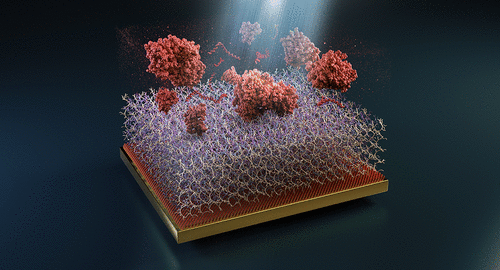Our official English website, www.x-mol.net, welcomes your
feedback! (Note: you will need to create a separate account there.)
Surface Preconditioning Influences the Antifouling Capabilities of Zwitterionic and Nonionic Polymer Brushes.
Langmuir ( IF 3.7 ) Pub Date : 2020-06-08 , DOI: 10.1021/acs.langmuir.0c00996 Ivana Víšová 1 , Markéta Vrabcová 1 , Michala Forinová 1 , Yulia Zhigunová 1 , Vasilii Mironov 1 , Milan Houska 1 , Eva Bittrich 2 , Klaus-Jochen Eichhorn 2 , Hisham Hashim 3, 4 , Petr Schovánek 1, 5 , Alexandr Dejneka 1 , Hana Vaisocherová-Lísalová 1
Langmuir ( IF 3.7 ) Pub Date : 2020-06-08 , DOI: 10.1021/acs.langmuir.0c00996 Ivana Víšová 1 , Markéta Vrabcová 1 , Michala Forinová 1 , Yulia Zhigunová 1 , Vasilii Mironov 1 , Milan Houska 1 , Eva Bittrich 2 , Klaus-Jochen Eichhorn 2 , Hisham Hashim 3, 4 , Petr Schovánek 1, 5 , Alexandr Dejneka 1 , Hana Vaisocherová-Lísalová 1
Affiliation

|
Polymer brushes not only represent emerging surface platforms for numerous bioanalytical and biological applications but also create advanced surface-tethered systems to mimic real-life biological processes. In particular, zwitterionic and nonionic polymer brushes have been intensively studied because of their extraordinary resistance to nonspecific adsorption of biomolecules (antifouling characteristics) as well as the ability to be functionalized with bioactive molecules. However, the relation between antifouling behavior in real-world biological media and structural changes of polymer brushes induced by surface preconditioning in different environments remains unexplored. In this work, we use multiple methods to study the structural properties of numerous brushes under variable ionic concentrations and determine the impact of these changes on resistance to fouling from undiluted blood plasma. We describe different mechanisms of swelling, depending on both the polymer brush coating properties and the environmental conditions that affect changes in both hydration levels and thickness. Using both fluorescent and surface plasmon resonance methods, we found that the antifouling behavior of these brushes is strongly dependent on the aforementioned structural changes. Moreover, preconditioning of the brush coatings (incubation at a variable salt concentration or drying) prior to biomolecule interaction may significantly improve the antifouling performance. These results suggest a new simple approach to improve the antifouling behavior of polymer brushes. In addition, the results herein enhance the understanding for improved design of antifouling and bioresponsive brushes employed in biosensor and biomimetic applications.
中文翻译:

表面预处理会影响两性离子和非离子聚合物刷的防污能力。
聚合物刷不仅代表了用于众多生物分析和生物学应用的新兴表面平台,而且创建了先进的表面束缚系统来模仿现实生活中的生物过程。特别地,两性离子和非离子聚合物刷由于其对生物分子非特异性吸附的非凡抵抗性(防污特性)以及被生物活性分子官能化的能力,已得到了广泛的研究。然而,在现实世界的生物介质中的防污行为与在不同环境中通过表面预处理引起的聚合物刷的结构变化之间的关系尚待探索。在这项工作中 我们使用多种方法来研究各种离子浓度不同的刷子的结构特性,并确定这些变化对未稀释血浆对污垢的抵抗力的影响。我们描述了不同的溶胀机理,这取决于聚合物刷的涂料性能和影响水合度和厚度变化的环境条件。使用荧光和表面等离振子共振方法,我们发现这些刷子的防污性能在很大程度上取决于上述结构变化。此外,在生物分子相互作用之前对刷涂进行预处理(在可变盐浓度下干燥或干燥)可以显着提高防污性能。这些结果表明,一种新的简单方法可以改善聚合物刷的防污性能。另外,本文的结果增强了对用于生物传感器和仿生应用中的防污刷和生物响应刷的改进设计的理解。
更新日期:2020-07-28
中文翻译:

表面预处理会影响两性离子和非离子聚合物刷的防污能力。
聚合物刷不仅代表了用于众多生物分析和生物学应用的新兴表面平台,而且创建了先进的表面束缚系统来模仿现实生活中的生物过程。特别地,两性离子和非离子聚合物刷由于其对生物分子非特异性吸附的非凡抵抗性(防污特性)以及被生物活性分子官能化的能力,已得到了广泛的研究。然而,在现实世界的生物介质中的防污行为与在不同环境中通过表面预处理引起的聚合物刷的结构变化之间的关系尚待探索。在这项工作中 我们使用多种方法来研究各种离子浓度不同的刷子的结构特性,并确定这些变化对未稀释血浆对污垢的抵抗力的影响。我们描述了不同的溶胀机理,这取决于聚合物刷的涂料性能和影响水合度和厚度变化的环境条件。使用荧光和表面等离振子共振方法,我们发现这些刷子的防污性能在很大程度上取决于上述结构变化。此外,在生物分子相互作用之前对刷涂进行预处理(在可变盐浓度下干燥或干燥)可以显着提高防污性能。这些结果表明,一种新的简单方法可以改善聚合物刷的防污性能。另外,本文的结果增强了对用于生物传感器和仿生应用中的防污刷和生物响应刷的改进设计的理解。


















































 京公网安备 11010802027423号
京公网安备 11010802027423号